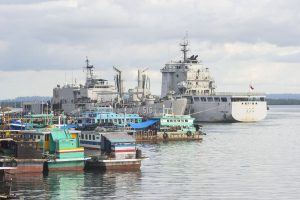“If we say prioritize everything, then we might as well say prioritize nothing,” one Southeast Asian defense official recently noted on the sidelines of a forum, referring to the state of regional maritime security. The comment captured the difficulties inherent in continuing to address comprehensive maritime security challenges while also managing intensifying strategic competition, which is evident in areas like grey zone coercion or undersea cables. That balance is critical within the broader issue of how to navigate and prioritize within Southeast Asia’s crowded maritime agenda.
Maritime security has long been crucial for much of Southeast Asia. The region is home to critical sea lanes like the Malacca Straits and some of the world’s largest archipelagic nations like Indonesia and the Philippines. (Manila’s coastlines are in fact longer than those of the United States.) The South China Sea disputes, minilateral patrols, and proliferating military drills tend to get the most headlines because of their kinetic nature. But they obscure a wider set of comprehensive maritime challenges that are critical for inclusive and sustainable development. These include piracy, illegal fishing, marine debris, and disaster preparedness.
Intensifying major power competition over the past few years has added yet another challenge. Countries have had to intensify preparedness not just for grey zone coercion, but also increasingly complex maritime cyber attacks, threats to subsea cables, and the securitization of economic cooperation in areas like port management. The challenges in areas like capacity, coordination, and complexity are real. As it is, defense officials from some Southeast Asian countries privately acknowledge they lack full maritime domain awareness (MDA) across their own waters, with true MDA being defined as not just access to proliferating MDA products but the ability to share data and then act on it. Meanwhile, at the regional level, even recent attempts to focus the agenda, like the maritime pillar of the ASEAN Outlook on the Indo-Pacific, have specified no less than 25 agenda items.
While managing this rising maritime security agenda challenge is not impossible, it will require a shared and multi-stakeholder effort. This begins with forward-leaning countries in Southeast Asia. New initiatives like the ASEAN Maritime Outlook or the ASEAN Coast Guard Forum deserve credit for trying to modernize and streamline the regional maritime agenda, and countries like Indonesia or the Philippines can play differentiated roles in helping advance them. Thailand’s past work on sustainability and Singapore’s advocacy on issues like submarine safety also deserve a mention, with the latter having been difficult to implement previously but critical to keep on the agenda given the increasingly crowded surface and subsurface space. Southeast Asian states should also continue tackling lingering differences in areas like boundary management, illegal fishing, or resource management issues in the South China Sea, irrespective of progress in the wider ASEAN-China track.
Beyond the region itself, outside actors can play an important role as well. Organizations can intensify their efforts to work with individual Southeast Asian states and ASEAN as a grouping where agendas intersect. Form should follow function, and efforts should transcend binary thinking such as the overstated zero-sum dynamic between minilaterals and multilaterals. Quad countries can accelerate the role they have been playing in MDA technology capacity-building to help Southeast Asian states navigate the marketplace of proliferating products. The G-7 can emphasize common touchpoints, as it did with its mention of ASEAN in a recent maritime security declaration across areas like maritime supply chain resilience, energy and food security. And institutions like the International Cable Protection Committee can also work with ASEAN as it seeks to update previous steps like streamlining the permitting application process for cable repair.
To be sure, there is no exact science in how Southeast Asia can calibrate managing intensifying major power competition and tackling a comprehensive set of maritime security challenges. As the past few decades have shown, sudden crises or new developments can quickly reshape the mix of urgent and important priorities for policymakers. Nonetheless, by at least continuing to try to find a balance, policymakers can help ensure that an adaptive and inclusive approach is being sustainably adopted across the maritime domain.

































